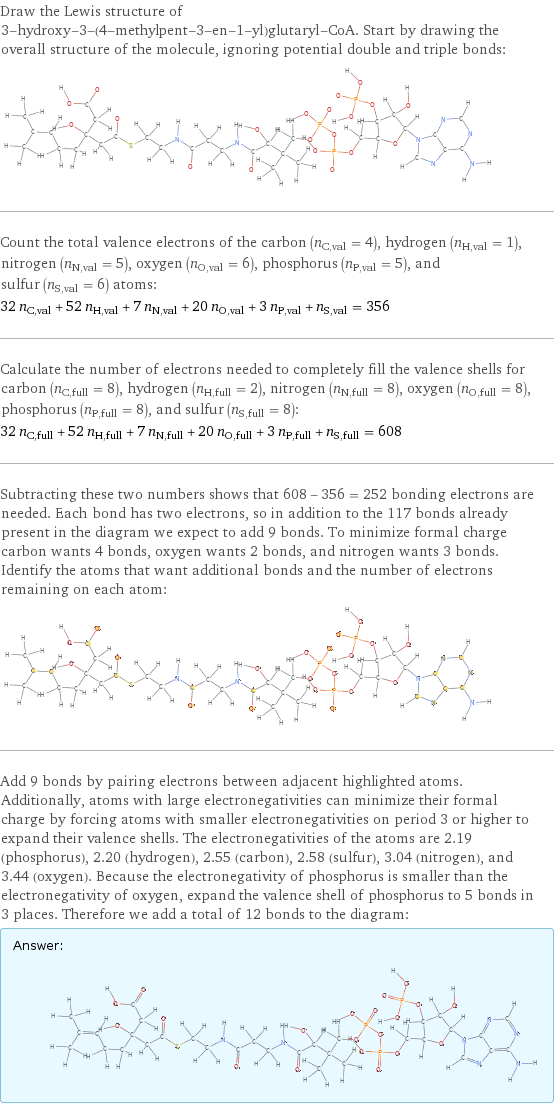Input interpretation

3-hydroxy-3-(4-methylpent-3-en-1-yl)glutaryl-CoA
Chemical names and formulas

formula | C_32H_52N_7O_19P_3S_1 Hill formula | C_32H_52N_7O_19P_3S name | 3-hydroxy-3-(4-methylpent-3-en-1-yl)glutaryl-CoA mass fractions | C (carbon) 39.2% | H (hydrogen) 5.35% | N (nitrogen) 10% | O (oxygen) 32.7% | P (phosphorus) 9.48% | S (sulfur) 3.27%
Lewis structure

Draw the Lewis structure of 3-hydroxy-3-(4-methylpent-3-en-1-yl)glutaryl-CoA. Start by drawing the overall structure of the molecule, ignoring potential double and triple bonds: Count the total valence electrons of the carbon (n_C, val = 4), hydrogen (n_H, val = 1), nitrogen (n_N, val = 5), oxygen (n_O, val = 6), phosphorus (n_P, val = 5), and sulfur (n_S, val = 6) atoms: 32 n_C, val + 52 n_H, val + 7 n_N, val + 20 n_O, val + 3 n_P, val + n_S, val = 356 Calculate the number of electrons needed to completely fill the valence shells for carbon (n_C, full = 8), hydrogen (n_H, full = 2), nitrogen (n_N, full = 8), oxygen (n_O, full = 8), phosphorus (n_P, full = 8), and sulfur (n_S, full = 8): 32 n_C, full + 52 n_H, full + 7 n_N, full + 20 n_O, full + 3 n_P, full + n_S, full = 608 Subtracting these two numbers shows that 608 - 356 = 252 bonding electrons are needed. Each bond has two electrons, so in addition to the 117 bonds already present in the diagram we expect to add 9 bonds. To minimize formal charge carbon wants 4 bonds, oxygen wants 2 bonds, and nitrogen wants 3 bonds. Identify the atoms that want additional bonds and the number of electrons remaining on each atom: Add 9 bonds by pairing electrons between adjacent highlighted atoms. Additionally, atoms with large electronegativities can minimize their formal charge by forcing atoms with smaller electronegativities on period 3 or higher to expand their valence shells. The electronegativities of the atoms are 2.19 (phosphorus), 2.20 (hydrogen), 2.55 (carbon), 2.58 (sulfur), 3.04 (nitrogen), and 3.44 (oxygen). Because the electronegativity of phosphorus is smaller than the electronegativity of oxygen, expand the valence shell of phosphorus to 5 bonds in 3 places. Therefore we add a total of 12 bonds to the diagram: Answer: | |
Basic properties

molar mass | 979.8 g/mol
Units

Chemical identifiers
(C)COP(=O)(O)OP(=O)(O)OC[C@@H]1[C@H]([C@H]([C@H](N2C=NC3=C(N)N=CN=C32)O1)O)OP(=O)(O)O)O)O)C](../image_source/c1f284d3893767b126a641c77cbf853d.png)
SMILES identifier | CC(=CCCC(CC(=O)O)(CC(=O)SCCNC(=O)CCNC(=O)[C@@H](C(C)(C)COP(=O)(O)OP(=O)(O)OC[C@@H]1[C@H]([C@H]([C@H](N2C=NC3=C(N)N=CN=C32)O1)O)OP(=O)(O)O)O)O)C